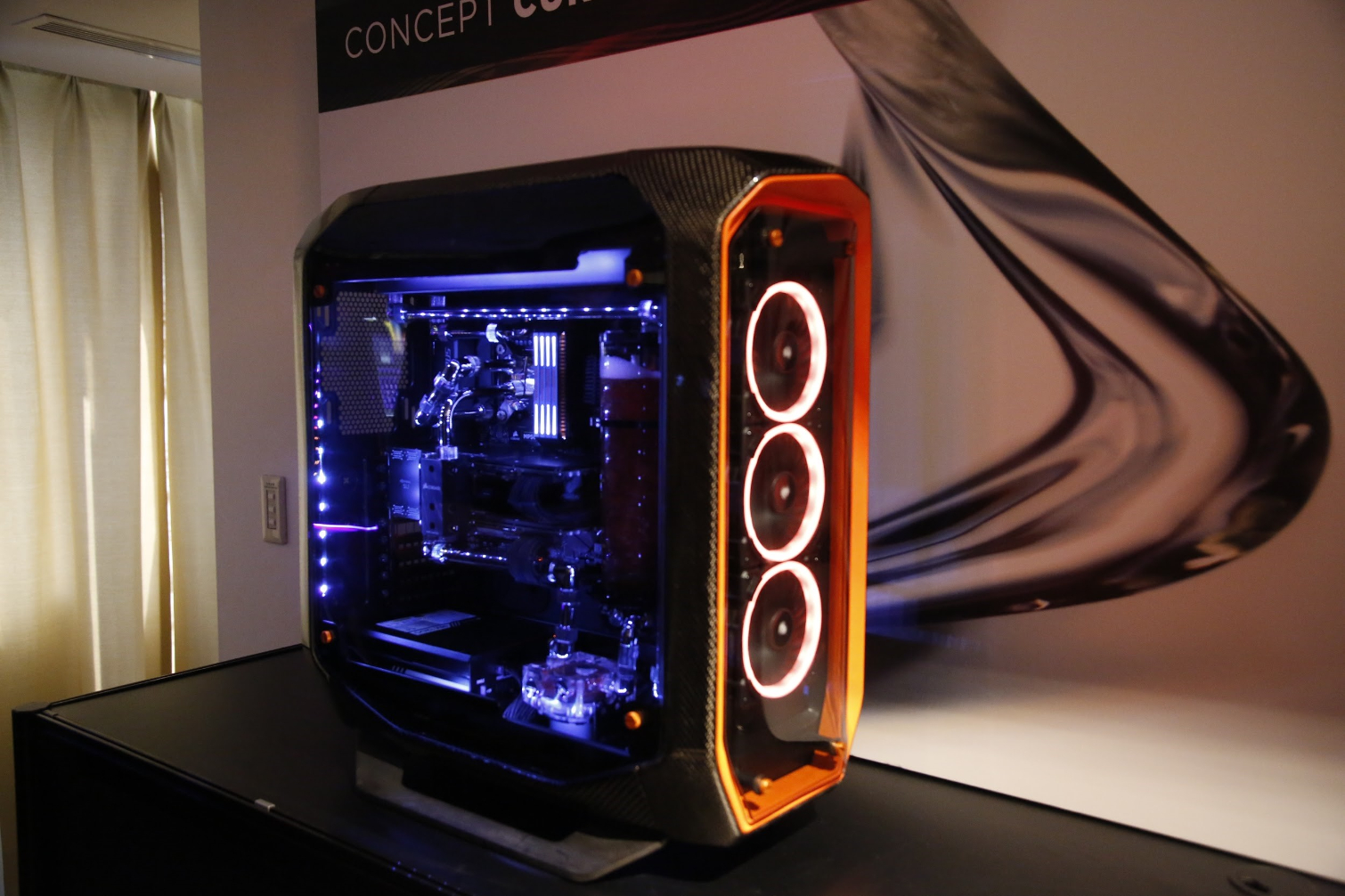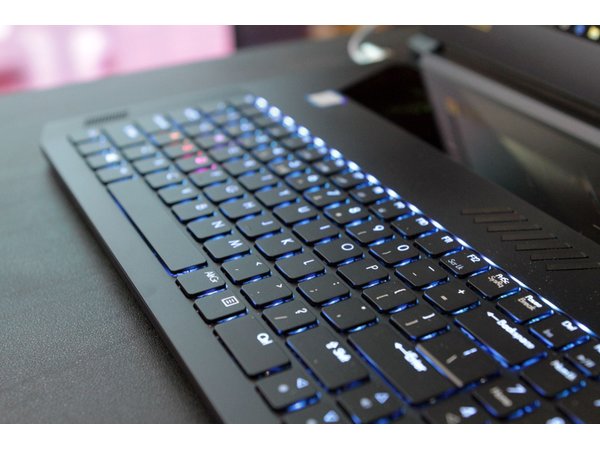Tom’s Hardware Best Of Computex 2017
Best Gaming Laptop Trend
Thin Is In
With Nvidia’s Max-Q Design philosophy making its debut, we were given a glimpse of where the enthusiast gaming laptop market is headed. Thin is in, and it has been for quite some time, but now gamers don’t have to compromise performance to get a light and powerful notebook with a skinny profile. With Asus, Clevo, MSI, Acer, and Gigabyte leading the charge (with more vendors joining the fray with their own Max-Q laptops later), we anticipate these thin-yet-powerful devices will usher in a new era of enthusiast mobile gaming.
Max-Q aside, we saw plenty of regular gaming laptops that are also riding the thin-and-light wave.
Most Exciting NAS
Thecus N2350
Yes, “most exciting NAS,” as oxymoronic as that sounds. The lowest-priced NAS in our 6-Way 2-Bay NAS roundup costs $169.99. Several companies have products in that range, and it would have been easy for Thecus to return there with the new N2350 2-bay NAS, which is loaded with the latest ThecusOS7 operating system.
Instead of following the herd, Thecus took a leap of faith to entice new users with a lower price point. The Marvell Armada 385 dual-core SoC processor won’t break any benchmark records, but it’s strong enough to tackle your data transfers at high speeds and run some applications in the background.
The goal is to bring users into the connected world where software overshadows the core functions most associated with products: data storage. Once indoctrinated, you can use the N2350 for what it is or step up to a system with more features, like powerful multimedia through HDMI and more resource-hungry applications. But the Thecus N2350 will get you in the door for a taste test without breaking the bank. You should like it enough to want more features in your next NAS, and that’s why we like this model, at this price, so much.
Get Tom's Hardware's best news and in-depth reviews, straight to your inbox.
Best SSD
Intel Optane SSD (Proposed 900p)
Intel didn’t announce the upcoming 900p at Computex but did take the stage for a brief moment in the spotlight. The 900p looks amazing in the leaked slides, but even as vaporware, it has our vote over the TLC race-to-the bottom we saw all week.
The next-generation consumer SSDs have weak controller designs with low core counts. Most of the processing power will be used by powerful error correction technology needed to ensure product life from 1,000 to 1,500 P/E cycle 3D TLC. NAND flash companies plan to erase MLC from the board in the 3D era. That will push many of our readers to Intel’s 3D Xpoint technology used in the proposed 900p and Optane Memory paired with hard disk drives.
Enthusiasts and early adopters who funded a large portion of the NAND development over the last decade will find 3D TLC a bust at this stage. In the future, we may see stronger products designed for enthusiasts, gamers, and power users, but for now we have only two viable alternatives: Samsung V-NAND and Intel Optane. Samsung didn’t display any products publicly at Computex, so Intel gets the pudding this time around.
Most Promising Peripheral Technology
Flaretech (Maybe Analog) Mechanical Laptop Switches
We’ve written about how analog keyboard switches could be a big deal for gaming, and when we went to visit with Wooting (maker of the One) at the Adomax booth at Computex, we found new Flaretech low-profile mechanical switches. They’re designed for laptops and/or super-slim keyboards, but they also might be made to work for analog input.
Theoretically, it should be easy, but we say that with an asterisk, because even the folks who know the switch well and also know how to make analog input work haven’t had a chance to do a full technical teardown yet. Thus, there could be an unforeseen technical issue that crops up.
Still, it seems quite likely that the low-profile Flaretech switch will be capable of analog input, and if an OEM sees fit to load them onto a gaming laptop...well, you can do the math: It gets you analog input on a mechanical keyboard on a slim gaming laptop. Pardon us while we swoon.
Best Keyboard
Tex Yoda II
It’s usually terribly difficult to suss out a “best” keyboard when you see so many good ones over the course of a week, but the Yoda II stood out from the rest. Built by Tex, a two-man operation, the Yoda II has a TrackPoint (or a non-copyrighted version) mounted in the middle of it, with three keys below the spacebar that perform mouse functions.
That’s right: With this fully mechanical keyboard, you don’t actually need a mouse. When you combine that with the svelte form factor, CNC’d aluminum chassis, and clever configurator tool, the Yoda II is catnip for keyboard enthusiasts--especially for those who love the iconic BM/Lenovo TrackPoint.
Most Expensive Case
Corsair Carbon
Computex did not want for new cases--we saw so many new ones that we stopped counting at 50 billion--but a few case vendors pulled out all the stops. Thermaltake proudly had the Level 20 case on display, with its tempered glass and aluminum (both 5mm thick) materials and tricked-out cooling and lighting. A rep told us that it cost (probably about) $7,000 to put that particular rig together.
But that’s nothing compared to how much it cost Corsair to deliver its carbon fiber-wrapped Concept Carbon case. The case alone contains about $10,000 worth of carbon fiber.
Corsair isn’t going to charge $10,000 for a case; indeed, reps told us that more than anything, they wanted to show off what could be possible with “exotic” materials and cases. But if you did want to go and ask Corsair to sell you a Concept Carbon, you better sell your car first or take out a loan.
Best Laptop Keyboard
MSI GT75VR And Acer Triton 700
As we expected, Computex brought us mechanical switches in laptop keyboards. But now, instead of trying to stuff full-size desktop switches into thick, cumbersome laptops, MSI and Acer tricked out their new thin gaming laptops with low-profile mechanical switches. Even better, they’re RGB switches (because of course they are).
The big system builders, including Asus and Gigabyte, all had new thin and light gaming laptops to show off (and goodness, they’re all quite attractive), but MSI and Acer deserve credit for going all-out with real mechanical switches that don’t add any extra thickness to the already-thin chassis.
‘Coolest’ Case
Calyos NSG-S0
We’ve seen the Calyos NSG-S0 fanless chassis at previous tradeshows, but at Computex it once again caught our attention. This is a case that cools down all components through a phase-change cooling system.
The NSG-S0 doesn’t use cooling fans, and it doesn’t host a water cooling kit either, meaning that it remains totally silent under all conditions. Even the PSU it uses lacks a fan--because it’s a Seasonic Prime fanless unit (which hasn’t been officially released yet).
Phase-change cooling used to be popular among highly enthusiast users and overclockers about 10 years ago, before the wide adoption of LN2; back in those days, though, these systems weren’t quiet--at all--because they had to use high-speed fans to cool down their condensers and strong compressing units. We still remember the loud noise the heavily modded Prometeia phase-change systems made, in order to cope with 250W and 300W loads and keep the temperatures well below zero.
Obviously, Calyos found a way to offer enhanced cooling capabilities through a phase-change system, without using any moving parts like cooling fans or compressors. The Calyos case isn’t affordable, unfortunately, but currently it’s the only chassis capable of zero noise output even with a strong CPU and GPU gaming-oriented configuration.
Best PSU
Aerocool P7-650W Platinum
Aerocool’s Project 7 products look to be of high quality, and this applies to the upcoming PSU models as well, which are based on a highly efficient Andyson platform (which normally offers Titanium efficiency). The most interesting member of the Project 7 PSU line is the P7-650W Platinum, because for the first time an OEM collaborated with an IT site (in this case TechPowerUp) in order to offer a high-performance, silent, and reliable PSU that meets the increased demands of enthusiast users.
This isn’t the same platform used in the existing high-end Andyson units; it’s a modified one offering longer hold-up time, along with numerous performance improvements and a full protection set that includes OTP. The same PSU is also among the first certified by Cybenetics, and aside from a high efficiency rating (ETA-B), it also carries a LAMBDA-A++ rating, which is given to PSUs with lower than 20 dB(A) overall noise.
Most Tempered Glass
Thermaltake View 71 G And Cougar Panzer Evo
Judging by what we saw on the showroom floor at Computex, the two biggest trends in computer cases right now would be RGB lighting and tempered glass. The Thermaltake View 71 TG and the Cougar Panzer Evo have the latter in abundance.
Whereas most companies are content with slapping a tempered glass side panel on a case and calling it good, Thermaltake and Cougar pulled out all the stops with 5mm tempered glass side panels on the front, top, and both sides of their respective cases. Although that may sound like overkill to some, one look at the View 71 TG and Panzer Evo would suggest otherwise. The tempered glass panels complement the chassis' aesthetics nicely and allow full view of your RGB-lit system components and sensational liquid cooling.
Tom's Hardware is the leading destination for hardcore computer enthusiasts. We cover everything from processors to 3D printers, single-board computers, SSDs and high-end gaming rigs, empowering readers to make the most of the tech they love, keep up on the latest developments and buy the right gear. Our staff has more than 100 years of combined experience covering news, solving tech problems and reviewing components and systems.










